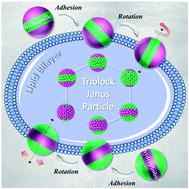当前位置:
X-MOL 学术
›
Mol. Syst. Des. Eng.
›
论文详情
Our official English website, www.x-mol.net, welcomes your
feedback! (Note: you will need to create a separate account there.)
Manipulating the interactions between the lipid bilayer and triblock Janus nanoparticles: insight from dissipative particle dynamics
Molecular Systems Design & Engineering ( IF 3.2 ) Pub Date : 2021-1-4 , DOI: 10.1039/d0me00146e Jiawei Li 1, 2, 3, 4 , Junfeng Wang 1, 2, 3, 4 , Youguo Yan 1, 2, 3, 4 , Zhen Li 1, 2, 3, 4 , Jun Zhang 1, 2, 3, 4
Molecular Systems Design & Engineering ( IF 3.2 ) Pub Date : 2021-1-4 , DOI: 10.1039/d0me00146e Jiawei Li 1, 2, 3, 4 , Junfeng Wang 1, 2, 3, 4 , Youguo Yan 1, 2, 3, 4 , Zhen Li 1, 2, 3, 4 , Jun Zhang 1, 2, 3, 4
Affiliation

|
Triblock Janus nanoparticles (TJPs) have demonstrated unique physical properties that make them beneficial for versatile biomedical applications, but there is a lack of understanding on the effect of hydrophobic–hydrophilic patch arrangement on TJP–bilayer interactions. Here, by adopting dissipative particle dynamics simulations, the interplay between the bilayer and TJPs with different hydrophobic–hydrophilic patches is systematically studied. By scrutinizing the complete transmembrane process of different TJPs, we reveal that the hydrophobic–hydrophilic patch arrangement of TJPs significantly affects the internalization pathway of TJPs, as well as the dynamic behaviors and stability of internalized TJPs. The TJPs with hydrophilic patches on two poles are more stable within the bilayer but their internalization process is more time-consuming. The TJPs with hydrophilic patches on two poles possess better penetration capability across the lipid bilayer due to their metastable configuration within the bilayer. Meanwhile, the ratio of hydrophobic–hydrophilic patches of TJPs is a secondary factor influencing the TJP–bilayer interactions. These findings demonstrate that the interactions between TJPs and the bilayer can be regulated by manipulating the hydrophobic–hydrophilic patch arrangement of TJPs, which provide valuable information for designing hybrid nanocomposites and facilitate the potential application of TJPs.
中文翻译:

操纵脂质双层和三嵌段Janus纳米颗粒之间的相互作用:耗散颗粒动力学的见解
Triblock Janus纳米颗粒(TJPs)表现出独特的物理性能,使其对多种生物医学应用有益,但对疏水-亲水膜片排列对TJP-双层相互作用的影响尚缺乏了解。在这里,通过采用耗散粒子动力学模拟,系统地研究了双层和具有不同疏水-亲水补丁的TJP之间的相互作用。通过研究不同TJPs的完整跨膜过程,我们发现TJPs的疏水-亲水膜片排列显着影响TJPs的内化途径,以及内在化TJPs的动力学行为和稳定性。在两极带有亲水性贴剂的TJP在双层内更稳定,但它们的内在化过程更加耗时。由于在双分子层中具有亚稳态构型,因此在两极具有亲水性贴片的TJP具有更好的跨脂质双分子层渗透能力。同时,TJPs疏水-亲水膜片的比例是影响TJP-双层相互作用的次要因素。这些发现表明,通过控制TJPs的疏水-亲水膜片排列可以调节TJPs与双层分子之间的相互作用,这为设计杂化纳米复合材料提供了有价值的信息,并促进了TJPs的潜在应用。TJPs疏水-亲水膜片的比例是影响TJP-双层相互作用的次要因素。这些发现表明,通过控制TJPs的疏水-亲水膜片排列可以调节TJPs与双层分子之间的相互作用,这为设计杂化纳米复合材料提供了有价值的信息,并促进了TJPs的潜在应用。TJPs疏水-亲水膜片的比例是影响TJP-双层相互作用的次要因素。这些发现表明,通过控制TJPs的疏水-亲水膜片排列可以调节TJPs与双层分子之间的相互作用,这为设计杂化纳米复合材料提供了有价值的信息,并促进了TJPs的潜在应用。
更新日期:2021-01-22
中文翻译:

操纵脂质双层和三嵌段Janus纳米颗粒之间的相互作用:耗散颗粒动力学的见解
Triblock Janus纳米颗粒(TJPs)表现出独特的物理性能,使其对多种生物医学应用有益,但对疏水-亲水膜片排列对TJP-双层相互作用的影响尚缺乏了解。在这里,通过采用耗散粒子动力学模拟,系统地研究了双层和具有不同疏水-亲水补丁的TJP之间的相互作用。通过研究不同TJPs的完整跨膜过程,我们发现TJPs的疏水-亲水膜片排列显着影响TJPs的内化途径,以及内在化TJPs的动力学行为和稳定性。在两极带有亲水性贴剂的TJP在双层内更稳定,但它们的内在化过程更加耗时。由于在双分子层中具有亚稳态构型,因此在两极具有亲水性贴片的TJP具有更好的跨脂质双分子层渗透能力。同时,TJPs疏水-亲水膜片的比例是影响TJP-双层相互作用的次要因素。这些发现表明,通过控制TJPs的疏水-亲水膜片排列可以调节TJPs与双层分子之间的相互作用,这为设计杂化纳米复合材料提供了有价值的信息,并促进了TJPs的潜在应用。TJPs疏水-亲水膜片的比例是影响TJP-双层相互作用的次要因素。这些发现表明,通过控制TJPs的疏水-亲水膜片排列可以调节TJPs与双层分子之间的相互作用,这为设计杂化纳米复合材料提供了有价值的信息,并促进了TJPs的潜在应用。TJPs疏水-亲水膜片的比例是影响TJP-双层相互作用的次要因素。这些发现表明,通过控制TJPs的疏水-亲水膜片排列可以调节TJPs与双层分子之间的相互作用,这为设计杂化纳米复合材料提供了有价值的信息,并促进了TJPs的潜在应用。











































 京公网安备 11010802027423号
京公网安备 11010802027423号